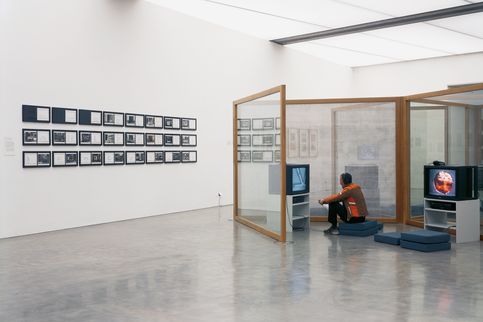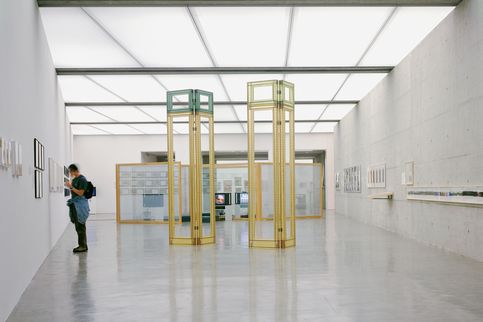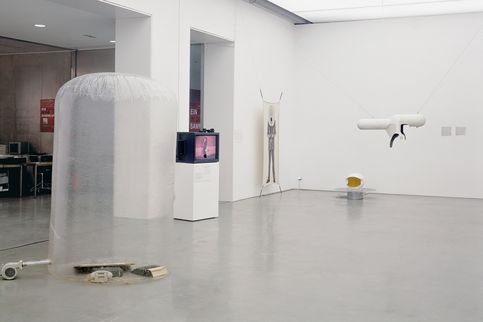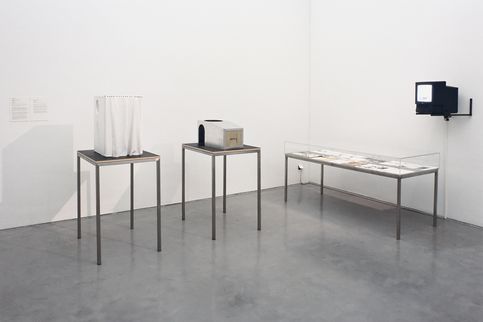Views of the Collection
Curator: Sabine Breitwieser
Curatorial Assistance, Exhibition production: Nadja Wiesener
This exhibition of works from the international collection of the Generali Foundation showed a representative survey of acquisitions from recent years. Generali’s collection activities are closely related to their exhibition activities. Some of the works in the collection presentation were therefore familiar from previous exhibitions and were revisited in the context of the collection. The majority of works were beeing shown in Vienna for the first time.
The exhibition was organized in terms of specific themes and had been animated by the relations established between the different works. Main concentrations were conceptual and performative aspects, architecture and design crossovers, as well as artistic positions that critically examine the role of the media and social parameters. The Reference Room (today: Generali Foundation Study Center), which houses the extensive video collection and the archives, which are conceptually integrated into the collection, acquired special significance in this exhibition.
The works that were on view were from internationally renowned artists such as Gottfried Bechtold, Carola Dertnig, VALIE EXPORT, Andrea Fraser, Rainer Ganahl, Isa Genzken, Bruno Gironcoli, Dan Graham, Hans Hollein, Mary Kelly, Dorit Margreiter, Gordon Matta-Clark, Walter Pichler, Mathias Poledna, Martha Rosler, Gerhard Rühm, Franz West, and Heimo Zobernig. Many of these artists, represented with large groups of works, are focal points of the collection.
Performative aspects of sculpture, for example, the theme of body/architecture/medial and social space, were addressed in a group of central works by members of the Austrian avant-garde, some of whom have attained international acclaim.
Exclusive rights to VALIE EXPORT’s legendary Expanded Cinema action, the "Tapp und Tast Kino" (Tap and Touch Cinema) (1968), a unique document, had recently been acquired by the Generali Foundation.. Faithfully reconstructed versions of the first and second "Tapp and Touch Cinema" were presented for the first time, accompanied by historical texts, photographs, and a video of the action in Munich. Also on view for the first time as part of the collection was Hans Hollein’s "The Mobile Office" (1969), a pneumatic room designed as an "office for transport in a suitcase." A small selection of the collection’s prototypes by Walter Pichler included "TV-Helmet" and "Small Room" (both 1967); the two central and most cited works of this period.
Franz West (a large selection of his works in the collection had been on view in the Generali Foundation’s previous presentation of the collection) is represented with "Studies for serious Music," video films (1986-88), which demonstrated the authentic use of his "Paßstücke" (Adaptives). A large series of silk-screened works from the early 1970ies revealed the canon of forms that characterize Bruno Gironcoli’s early sculptures, the most important of which are in the Generali Foundation Collection and have been shown a number of times.
These artists were juxtaposed with a series of international participants. For this particular exhibition, Dan Graham placed his selection of "favorite" videos, ranging from architecture to art and pop, in a new spatial context using his "New Design for Showing Videos" (1995). An extensive photo series of "Suburban Houses" (1963-85) by Graham, the basis of his legendary photo-text article "Homes for America" (1966/67), has been acquired by the Generali Foundation and was being shown in Austria for the first time. Another Austrian premiere was the six-part, photo-text project "Private Public Spaces: The Corporate Atrium Gardens" (1987), in which Graham and the architect Robin Hurst analyze the interaction between the urban environment and nature in terms of the semi-public gardens laid out in corporate atriums in the 1980ies in New York. Some time ago the Foundation acquired two key works by Gordon Matta-Clark, "Window Blow Out" (1973) and "Reality Positions, Fake Estate" (1973), both of which testify to the artist’s socially critical position and conceptual practice. These works, as well as Dan Graham’s video space, were on loan from the Generali Foundation for the documenta X (1976) and were being shown for the first time in the Foundation’s exhibition space in the context of the collection. Isa Genzken’s large, two-part sculpture "Bismarckstraße" (1994), two room-height, epoxy windows, was exhibited as a small sampling of her works in the collection.
"The Bowery in two inadequate descriptive systems" (1974-76) by Martha Rosler had functioned simultaneously as a link and dividing element between architecture, social space, and text. The photo-text installation already on display in the previously mounted survey of Rosler’s oeuvre was flanked by a group of Gerhard Rühm’s typocollages and photo montages from the fifties. Rühm was shown in conjunction with Rainer Ganahl, an exponent of a younger generation, who works with "education" to explore language/text and its institutional framework. Documentation in images and words also characterizes the artistic practice underlying Mary Kelly’s legendary "Post Partum Document" (1973-78), in which the mutual socialization of mother and child is investigated; it is represented in the collection with prototypes of "Documentation I." Since the prototypes of "Documentation I" were then on loan for a Whitney Museum exhibition, prototypes were shown of the "Introduction" and of "Documentation II." Photographs from the "Primapara Series" (1974) were also on view.
Another section of the exhibition presents films and film/video installations. Thus, for the first time viewers could see films by Gottfried Bechtold – "Phone," "BB," "Police," and "National Anthem" (all 1969) - shot on positive film and conceived as "sculptures," as well as VALIE EXPORT’s "Splitscreen-Solipsism" (1968) which is on display as an installation. Further a selection of Matta-Clark’s films about his series of most important building "cuttings" was present. Adjacent to these were a few works in which a younger generation of artists examines questions regarding institutions and the media. Installations by Heimo Zobernig, "Into Art" (1998) and by Dorit Margreiter, and Mathias Poledna’s "Fondazione" (1998) have all been made specifically for Generali Foundation exhibitions. A focal point of the exhibition was a text installation in several parts by Andrea Fraser, which evolved in the course of her project for the Generali Foundation and may only be shown in connection with the collection.
Since 1988, the Generali Foundation acquired impressive holdings, which are frequently loaned to exhibitions and thus made accessible for viewing world-wide. Shown in this exhibition were only a small selection from the collection’s existing blocks which differed from all previous exhibitions of the collection ("White Cube/Black Box", "Postproduction").
The core objective of the Generali Foundation is to set up an international collection focusing on contemporary sculpture as well as its research and documentation. The collection’s works date back to the mid-1960ies. These historical positions were juxtaposed with current ones from the 1990ies. The collection in no way claims to be a complete overview. Instead, it establishes concentrations on specific artistic viewpoints and issues. The term sculpture is not confined in the traditional sense to object art or plastic arts but is used broadly to embrace other media. Photography, film, video, and installation are thus likewise keynotes of the collection. Preservation and, if necessary, restoration of important historical bodies of works are among the Generali Foundation‘s most notable achievements. Special attention is paid to artists, especially women artists, who have made substantial contributions to contemporary art but have not received commensurate representation in institutions.
As a special opportunity, for the duration of the exhibition, the edition "postproduction" with works from VALIE EXPORT, Andrea Fraser, Isa Genzken, Bruno Gironcoli, Dan Graham, Elke Krystufek, Bertrand Lavier, Dorit Margreiter, Franz West, and Heimo Zobernig could be purchased at a 10 percent discount. (The edition ist sold out)






